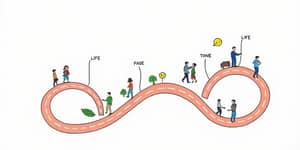In today's fast-paced world, uncertainty has become a constant companion. Rapid shifts in technology, economic cycles, and workforce dynamics demand that businesses and individuals alike adopt a strategic mindset. Proactive planning is no longer optional; it is the key to safeguarding your future against unforeseen challenges.
Why Proactive Planning Matters Today
The global economy is poised for growth in 2025–2026, yet volatility remains high. Organizations face rapid technological shifts and changing workforce demographics that can disrupt operations overnight. By embracing forward-looking strategies, decision-makers can build resilience and agility into their culture.
For individuals, the stakes are equally high. Personal finance landscapes are being reshaped by regulatory changes like the SECURE 2.0 Act, which introduces innovative retirement features such as student loan matching contributions and higher catch-up options for older workers. Without a proactive approach, workers risk falling behind on savings, benefits, and upskilling necessary for long-term security.
Pillars of Proactive Planning
At the heart of effective planning lies a framework identified by SHRM: the Four P's. These pillars provide a holistic blueprint for aligning resources, technology, and people with organizational goals.
- People: Focus on talent acquisition, continuous learning, and retention strategies to meet future skill demands.
- Productivity: Leverage technology and process improvements to maximize output and efficiency.
- Profitability: Link HR initiatives with financial objectives to drive ROI-driven decisions.
- Prosperity: Cultivate long-term foresight and adaptability for sustainable organizational strength.
Emerging Workforce and Benefits Trends for 2025–2026
Financial wellness has vaulted to the forefront of employer priorities, with 83% of plan sponsors acknowledging responsibility for their workforce's financial health (up from 74% in 2015). Meanwhile, 49% of retirement plan sponsors now take a proactive stance in plan design and enrollment, and 22% offer emergency savings features—despite 39% of employees lacking necessary reserves.
The SECURE 2.0 Act is accelerating retirement innovation, enabling features such as matching on student loan repayments and higher catch-up contributions for older employees. Benefits integration has deepened, with health savings accounts, telehealth, and tailored mental health options combining to foster hands-on benefit design and enrollment support.
The Technological Edge: AI and Analytics
Artificial intelligence and predictive analytics are transforming planning from reactive to anticipatory. By harnessing real-time predictive insights into future needs, organizations can forecast talent shortages, optimize labor costs, and maintain regulatory compliance with agility. In fact, 73% of employers plan to accelerate process automation as part of their 2025 workforce strategy.
Data-driven decision making not only reduces risk but also builds a narrative linking people investments to tangible business outcomes. Predictive models can flag potential turnover, skills gaps, and productivity bottlenecks before they impact the bottom line.
HR Leadership: Aligning People and Strategy
Strategic workforce planning no longer resides in departmental silos. Today's HR leaders champion cross-functional alignment and measurable outcomes, weaving together talent management, benefit design, and financial goals into a coherent strategy. Remote work, flexible schedules, and a focus on diverse life stages are reshaping how organizations attract and retain top talent.
By 2025, supporting employee well-being will be the top workforce strategy for 64% of employers, up dramatically from ninth on the list in 2023. This shift underscores the necessity of embedding health, financial resilience, and professional development into every facet of the employee experience.
Challenges and Gaps in Proactive Planning
Despite widespread adoption of proactive strategies, key challenges persist. Only 62% of employers express satisfaction with retirement plan advisors, a steep drop from 83% the year before. Gaps in fiduciary awareness, investment literacy, and comprehensive benefit offerings threaten to undermine well-intentioned efforts.
- Over half of plan sponsors lack clarity on fiduciary responsibilities.
- One-third of sponsors are unfamiliar with core investment options.
- Emergency savings programs remain scarce despite high demand.
- Women’s health benefits are often underrepresented, affecting engagement and outcomes.
Tangible Outcomes and Opportunities
Organizations that embrace proactive planning consistently outperform peers. Higher participation rates in savings and wellness programs, increased retention, and improved productivity all contribute to a measurable competitive edge. Employees enrolled in decision-support health plans are 129% more likely to make informed choices, enhancing both satisfaction and cost containment.
This correlation between foresight and profitability underscores why proactive planning is a defining factor for success in the coming decade.
Best Practices: Taking Action Now
Securing tomorrow requires a blend of vision, technology, and people-centered initiatives. Consider these best practices to drive momentum:
- Invest in continuous learning and digital leadership programs to close skill gaps.
- Implement robust analytics platforms for real-time workforce insights.
- Regularly review benefit designs, ensuring alignment with evolving employee needs.
- Adopt flexible and inclusive policy frameworks that support diverse talent.
- Leverage financial wellness and retirement innovations to boost security.
By integrating these approaches, leaders can transform uncertainty into opportunity and lay the groundwork for enduring prosperity.
Proactive planning is more than a strategy—it is a mindset that empowers organizations and individuals to navigate change, capitalize on emerging trends, and secure a brighter future. The time to act is now.
References
- https://www.investmentnews.com/retirement-planning/plan-sponsors-are-getting-proactive-in-challenging-times-but-need-more-from-advisors/261071
- https://blog.itreconomics.com/blog/proactive-planning-will-lead-to-a-prosperous-2025-and-2026
- https://www.shrm.org/enterprise-solutions/insights/strategic-planning-for-2025--what-business-leaders-need-to-know-
- https://www.naviabenefits.com/top-workplace-benefit-trends-to-watch-in-2025/
- https://www.crownedgrace.com/the-future-of-workforce-planning-trends-and-predictions-for-2025-and-beyond/
- https://www.benefitspro.com/2024/12/03/navigating-the-future-of-benefits-trends-and-strategies-for-2025/
- https://www.weforum.org/publications/the-future-of-jobs-report-2025/in-full/4-workforce-strategies/
- https://businessolver.com/blog/top-benefits-trends-hr-needs-to-know-for-the-second-half-of-2025/
- https://indeedflex.com/blog/for-employers/2025-workforce-planning-trends-key-insights-for-hr-professionals/










